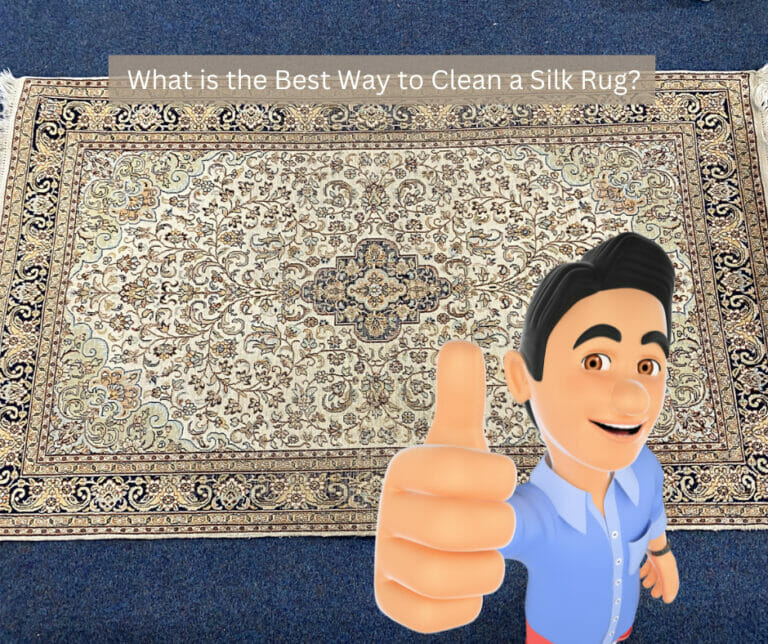We've had an influx of silk rugs recently, and so I thought it would be a good idea to write a blog about it and see if I can help a few others.
To help us I interviewed the lovely Pierre and that will be added at the end for if you wish to watch it... this one is an action one of Pierre actually washing a silk rug and the techniques we use to ensure your silk rug is looked after!

So, you’ve splurged on a gorgeous silk rug, and now you’re wondering how to maintain its beauty. Worry not! I’m about to guide you through a detailed and engaging journey on what is the best way to clean a silk rug.
We’ve all been there—pet accidents, wine spills, or simply the daily dust and grime can make your rug lose its lustre.
Well, put on your cleaning gloves and let’s dive in!
Before getting your rug wet, you’ll want to remove all that dry soil and dust. A specialised rug dusting machine is perfect for this task.
However, since silk is a delicate material, you’ll want to ensure that the beating is done gently.
What’s fascinating is that these machines come with a control to adjust the intensity of the beating to match the delicacy of the rug!
After dusting, you may think you’re ready to dive into washing. Hold your horses! It’s essential to test for colour movement first.
Even if you’ve cleaned dozens of silk rugs, each rug is unique. Apply the cleaning solution you intend to use onto a clean, absorbent cotton towel. Gently clamp the wet towel onto a small area of the rug.
If you notice any colour transfer to the towel, you’ll need to reconsider your cleaning solution or approach.
Ah, finally! It’s time to make your silk rug shine. Use cool, clean water to rinse the rug initially. Then, apply a specialised rug shampoo gently, preferably brushing it in by hand to ensure a gentle yet thorough clean.
Why by hand, you ask? Because silk threads can be extremely sensitive, especially when wet.
Due to how they weave them, if you notice curling at the edges of your rug, don’t freak out; silk rugs have this common characteristic. You’ll likely notice increased curling when the rug is wet.
Hand-clean these tricky areas, brushing in a single direction to prevent fibre damage.
After shampooing, it’s time to rinse. Run cool water over the rug until you’ve flushed out all the cleaning products.
This step is crucial, especially for areas that have stains or pet accidents.
Add a colour-setting product over the cleaned rug as an extra precaution. This not only adds another layer of protection against colour movement but can also brighten the colours of your rug.
Then, it’s time for the magic machine—enter the centrifuge. This marvel spins the rug to remove excess water, making the drying process much more efficient.
If you wish, you can apply a gentle rug protector to safeguard your silk masterpiece from future spills and stains.
Be cautious with the amount you apply; too much can potentially harm the sensitive silk fibres.
So, there you have it! A complete guide on making your silk rug look as splendid as the day you bought it.
The key takeaway?… Be gentle and cautious at every step. Silk is a delicate material that demands your time and attention, but the result is worth every minute!
Happy cleaning!
 Written by Tracey Gilbey, Marketing and Admin Coordinator at Art of Clean.
Written by Tracey Gilbey, Marketing and Admin Coordinator at Art of Clean.
For further advice or information on our Carpet and Soft Furnishing care, please do not hesitate to contact the Art of Clean team on 01223 901551 in Cambridge. Our services include Carpet Cleaning, Upholstery Cleaning, oriental and area Rug Cleaning, Curtain Cleaning, Patio, and Driveway Pressure washing, Leather Cleaning, Stone and Tile Floor Cleaning, and Wood Floor Sanding and Restoration. We also supply new flooring and carpets through our sister company Art of Flooring. Our Dry-Cleaning service is provided by Farthings Cambridge

For further advice or information on our Carpet and Soft Furnishing care, please do not hesitate to contact the Art of Clean team on 01223 901551 in Cambridge. Our services include Carpet Cleaning, Upholstery Cleaning, oriental and area Rug Cleaning, Curtain Cleaning, Patio, and Driveway Pressure washing, Leather Cleaning, Stone and Tile Floor Cleaning, and Wood Floor Sanding and Restoration. We also supply new flooring and carpets through our sister company Art of Flooring. Farthings Cambridge provides our Dry-Cleaning service